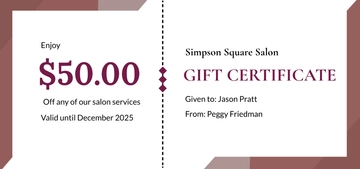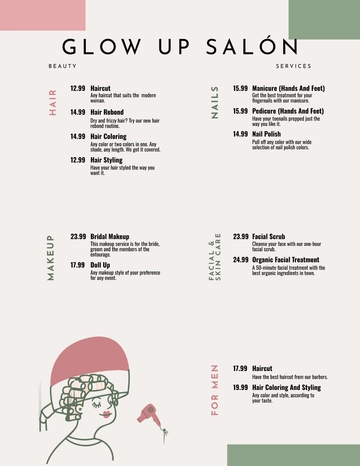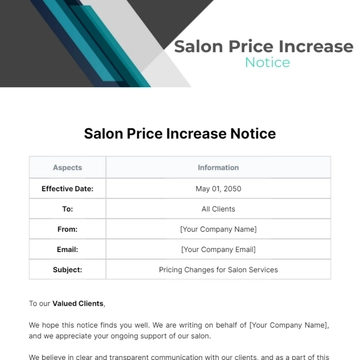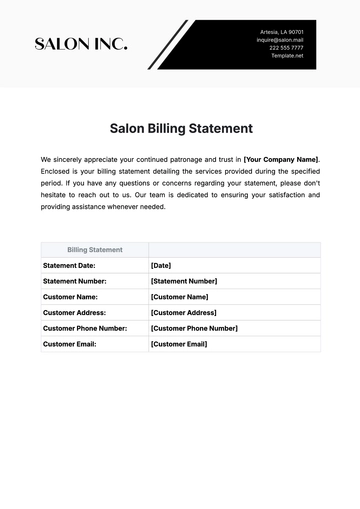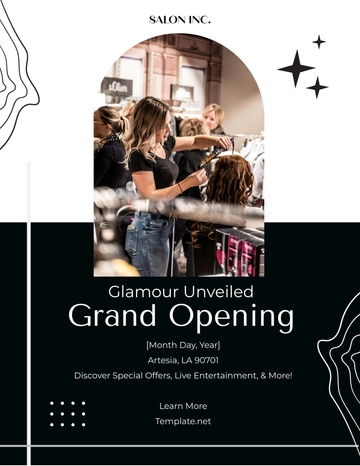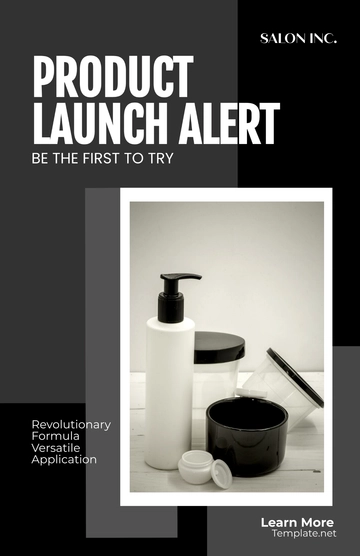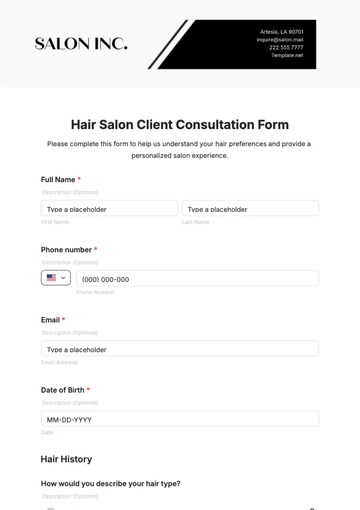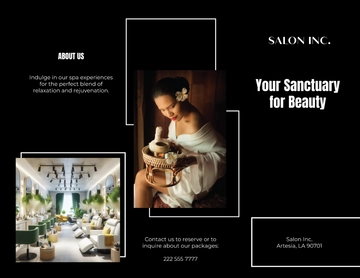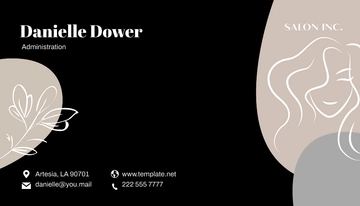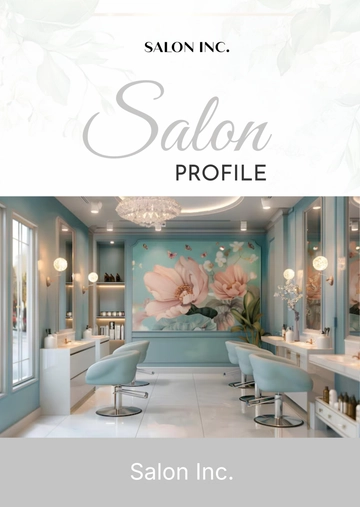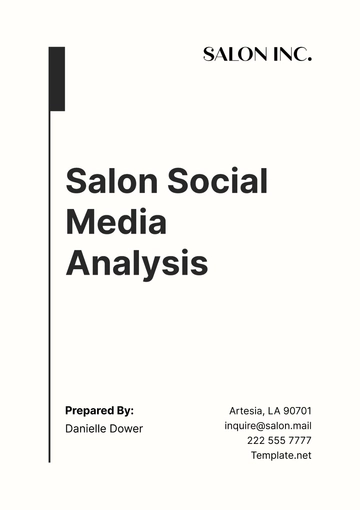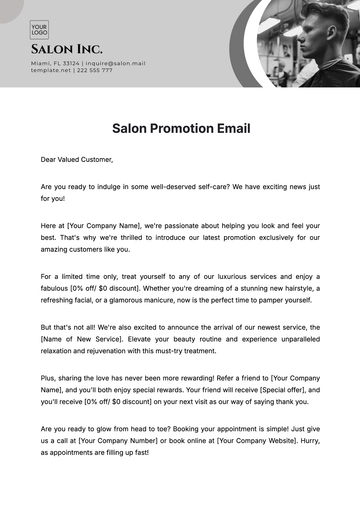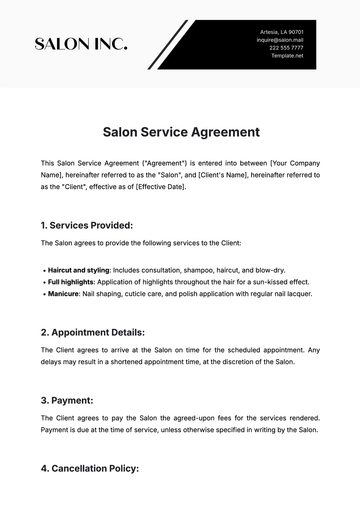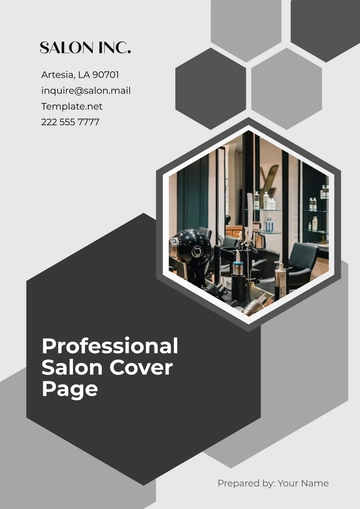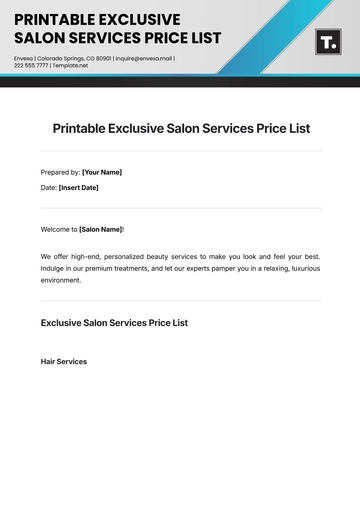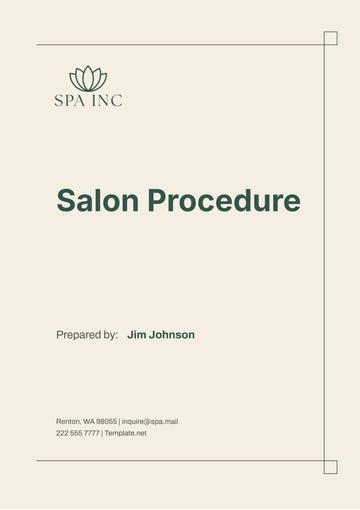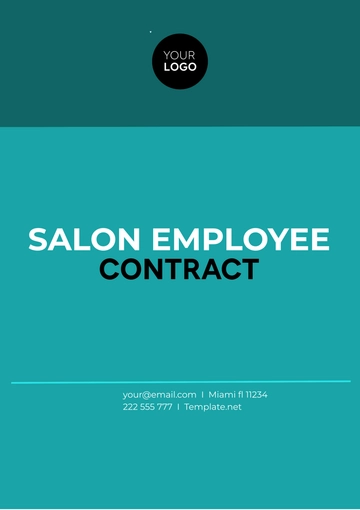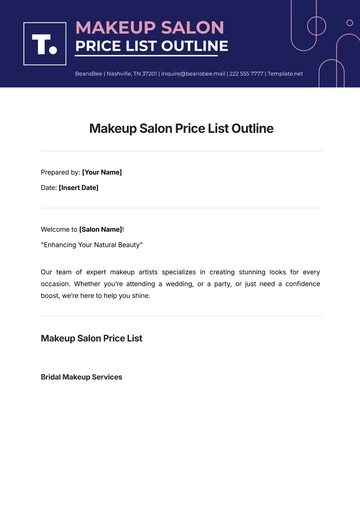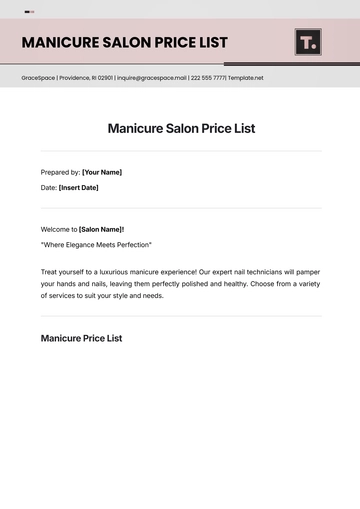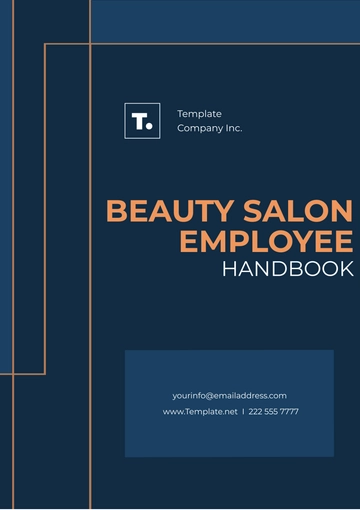Free Salon Growth Strategy
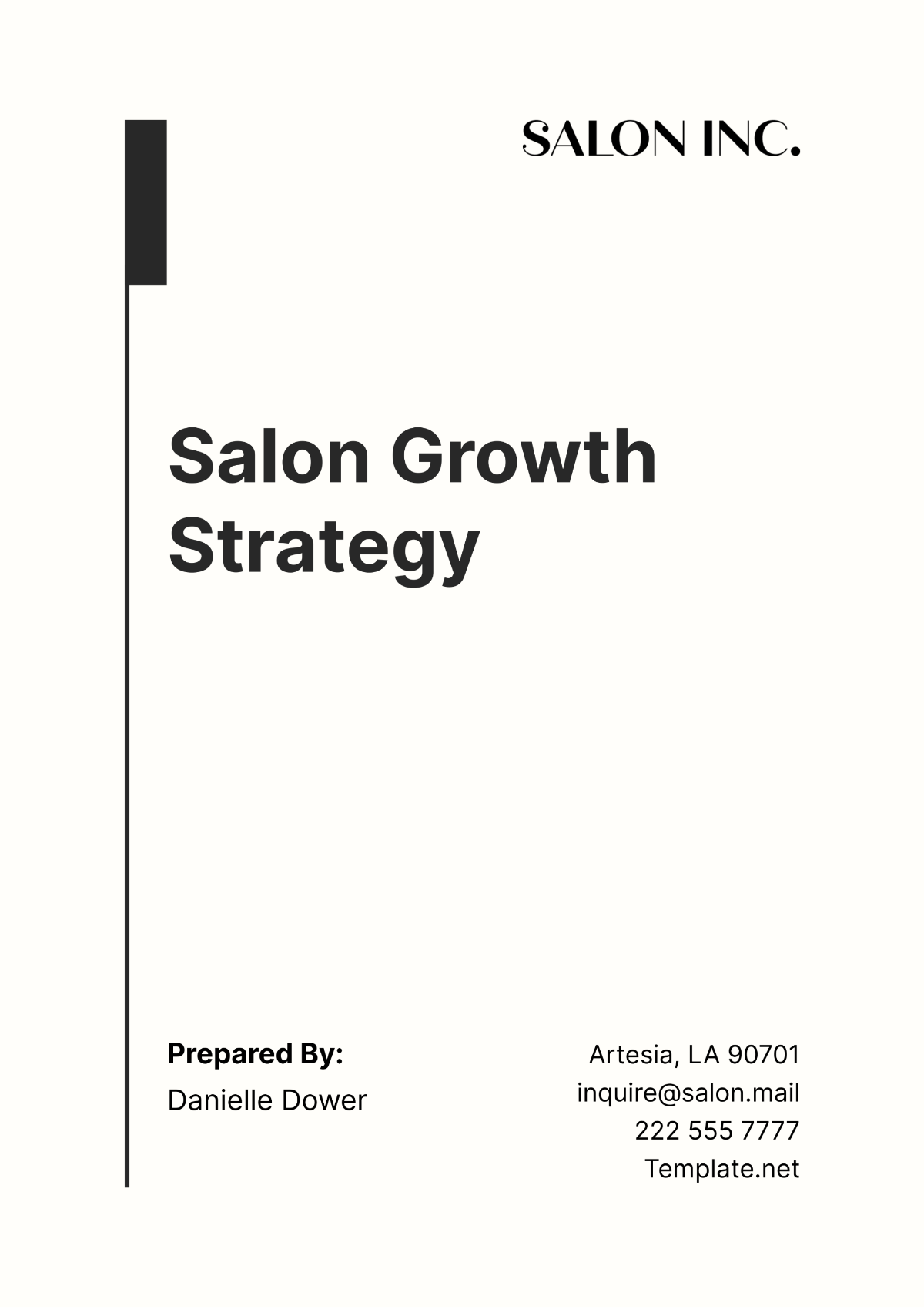
Chapter 1: Introduction
Welcome to the strategic growth document for [Your Company Name], a forward-thinking salon poised to redefine industry standards. This document serves as a blueprint for our expansion and refinement, detailing the strategies that will elevate our presence and profitability in the competitive beauty and wellness market. As we look ahead to the year 2050, our goal is to strengthen [Your Company Name]'s market position by embracing innovation, enhancing customer experiences, and expanding our geographic and digital footprint. This strategy is tailored to leverage our unique brand identity and operational strengths to achieve sustainable growth and increased market share.
Chapter 2: Executive Summary
[Your Company Name] is uniquely positioned to capture significant growth opportunities within the bustling salon industry. Our comprehensive growth strategy is crafted to expand our market share, refine our service offerings, and solidify a sustainable competitive edge by embedding innovation at the core of our customer interactions.
Our strategic initiatives are meticulously designed to boost client engagement, heighten brand awareness, and integrate cutting-edge technological tools. These initiatives are the cornerstone of our approach, ensuring not just growth but a significant enhancement in every facet of service delivery.
Key Aims for 2050:
Market Share: Increase our market share by targeting underserved regions and demographics, aiming for a 10% increase by the end of 2050.
Service Quality: Elevate service quality by adopting the latest in beauty technology and training our staff to excel in both skill and customer service.
Brand Identity: Enhance our unique brand identity by aligning our marketing strategies with the values and expectations of our target customers, focusing on personalized experiences and sustainable practices.
Chapter 3: Market Analysis
To navigate the competitive landscape and carve out a niche for [Your Company Name], a thorough understanding of market dynamics, consumer behavior, and competitive positioning is essential. Our market analysis for 2050 focuses on identifying the key areas for growth while acknowledging potential challenges that could impact our strategic decisions.
Detailed Analysis Components:
Customer Segmentation:
Demographics: Analyze age, gender, income levels, and employment status to tailor services that meet the specific needs of each group.
Psychographics: Study lifestyle choices, values, and beauty routines to offer customized service packages and marketing messages.
Competitor Analysis:
Service Offerings: Detailed comparison of the services offered by top competitors, focusing on their pricing, quality, and customer perceptions.
Market Positioning: Evaluate the marketing strategies and brand positioning of competitors to identify gaps and opportunities in the market.
Industry Trends:
Sustainability Practices: Exploration of emerging trends in sustainable beauty solutions and eco-friendly practices.
Technological Innovations: Identify advancements in salon technology, such as AI-driven beauty treatments and virtual reality beauty simulations
SWOT Analysis
The SWOT analysis provides a comprehensive overview of [Your Company Name]'s internal strengths and weaknesses, alongside the external opportunities and threats that could impact our strategic growth and operational efficiency. By examining these factors, we can better understand the current landscape and devise informed strategies that leverage our advantages, address our challenges, and capitalize on emerging trends to position [Your Company Name] as a leader in the competitive salon industry. This analysis will serve as a crucial tool in our decision-making process, ensuring that our actions are aligned with both market conditions and our long-term objectives.
Category | Factor | Details |
|---|---|---|
Strengths | High-quality service | Renowned for exceptional service quality that retains and attracts customers. |
Well-trained team | Staff are professionally trained and have expertise in the latest beauty treatments. | |
Loyal customer base | Strong repeat business due to high customer satisfaction and personalized service. | |
Weaknesses | Limited presence in high-growth areas | Concentration in saturated markets; lack of outlets in rapidly growing urban areas. |
Dependency on traditional marketing | Reliance on word-of-mouth and print advertising limits reach to new tech-savvy clients. | |
Opportunities | Expansion into online booking systems | Integrating technology to improve customer convenience and operational efficiency. |
Adoption of green technologies | Opportunity to lead the market by incorporating eco-friendly practices and products. | |
Threats | Economic downturns | Financial risks that could affect discretionary spending on beauty services. |
Aggressive competition in core markets | High competition in established markets could lead to price wars and profit erosion. |
Chapter 4: Objectives
The primary objectives for [Your Company Name] in 2050 are structured to drive significant growth, improve customer satisfaction, and expand our service offerings. These objectives are defined as SMART (Specific, Measurable, Achievable, Relevant, Time-bound) to ensure they are actionable and effective.
Strategic Objectives:
Clientele Increase:
Goal: Achieve a 20% increase in clientele by the end of 2050.
Measurement: Track new client registrations and repeat visits using our CRM system.
Customer Satisfaction:
Goal: Enhance customer satisfaction ratings by 10% through advanced CRM implementations.
Measurement: Use customer satisfaction surveys and feedback forms to assess improvements.
New Services:
Goal: Introduce at least three innovative beauty treatments by Q2 2050.
Measurement: Evaluate the uptake and profitability of new services through sales data and customer reviews.
Expansion:
Goal: Establish two new salon locations in key market areas by Q4 2050.
Measurement: Monitor the operational success and customer acquisition rates at new locations.
These objectives are designed to position [Your Company Name] as a leader in the salon industry, capable of adapting to changing market conditions and exceeding customer expectations. Through diligent planning, execution, and evaluation, we aim to achieve these goals efficiently and effectively, paving the way for a prosperous future in the beauty industry.
Chapter 5: Strategies
To achieve the ambitious objectives outlined in Chapter 4, [Your Company Name] will adopt several strategic initiatives designed to foster growth, enhance service delivery, and expand market presence. Each strategy is tailored to build upon our strengths and capitalize on opportunities while mitigating our weaknesses and guarding against potential threats.
Strategic Initiatives:
Targeted Marketing Campaigns:
Objective: Increase clientele and enhance brand visibility.
Actions:
Develop digital marketing strategies including social media campaigns, targeted ads, and influencer collaborations to reach broader demographics.
Employ traditional marketing tactics like local community events and print advertising to maintain engagement with existing customer bases.
Expected Outcome: Increased brand recognition and a 20% rise in clientele.
Staff Training and Development:
Objective: Ensure high-quality service delivery.
Actions:
Implement regular training programs on new beauty trends and customer service excellence.
Offer certifications and workshops to encourage continuous professional development.
Expected Outcome: Enhanced service quality and improved customer satisfaction ratings.
Technology Integration:
Objective: Improve operational efficiency and customer experience.
Actions:
Introduce an online booking and payment system to simplify appointment scheduling and transactions.
Deploy a customer relationship management (CRM) system to better track customer preferences and history.
Expected Outcome: Streamlined operations and increased customer retention through personalized service.
Partnerships with Product Suppliers:
Objective: Diversify and enhance product offerings.
Actions:
Negotiate with suppliers for exclusive deals on high-quality products.
Collaborate on cross-promotional activities that can offer mutual benefits and drive sales.
Expected Outcome: Improved product range and increased sales through strategic partnerships.
Chapter 6: Implementation Plan
To translate the strategies from Chapter 5 into tangible outcomes, a detailed implementation plan has been devised. This plan outlines the necessary steps, timelines, and responsibilities required to ensure successful execution of each strategic initiative.
Action Plan:
Quarter | Action Item | Responsible Department |
|---|---|---|
Q1 2050 | Finalize partnerships with product suppliers | Procurement & Marketing |
Q2 2050 | Deploy new CRM software | IT & Customer Service |
Q3 2050 | Launch new services and marketing campaigns | Marketing & Service Delivery |
Q4 2050 | Evaluate progress and adjust strategies | All Departments |
Resource Allocation: Adequate resources, including budget, personnel, and technology, will be allocated to each action item to ensure there are no delays or shortfalls.
Risk Management: Potential risks, such as delays in technology implementation or partnership negotiations, will be continuously monitored with predefined mitigation strategies in place.
Chapter 7: Evaluation and Control
For [Your Company Name] to continuously improve and adjust to the dynamic market environment, a robust system for evaluation and control is critical. This chapter outlines the mechanisms by which the success of the implemented strategies will be monitored and measured, ensuring alignment with our strategic objectives.
Monitoring Mechanisms:
Performance Indicators:
Customer Growth Rates: Track new and repeat client numbers monthly.
Financial Performance Metrics: Review profit margins and revenue growth quarterly.
Customer Service Feedback: Gather and analyze customer feedback on service quality and satisfaction after each visit.
Review Meetings:
Frequency: Conduct monthly operational meetings and quarterly strategic review meetings.
Participants: Include representatives from all departments to ensure comprehensive feedback and inclusive decision-making.
Focus: Assess the effectiveness of current strategies, discuss challenges, and adapt plans as necessary based on performance data and market changes.
Control System:
Feedback Loop: Establish a feedback mechanism that incorporates insights from customers, employees, and industry trends into strategic adjustments.
Benchmarking: Regularly benchmark [Your Company Name]'s performance against industry standards and competitors to gauge success and identify areas for improvement.
Through these structured evaluation and control processes, [Your Company Name] will maintain a flexible approach to its growth strategy, enabling quick adaptations to both challenges and opportunities as they arise. This will ensure the sustained success and competitiveness of our salon in the dynamic beauty industry.
- 100% Customizable, free editor
- Access 1 Million+ Templates, photo’s & graphics
- Download or share as a template
- Click and replace photos, graphics, text, backgrounds
- Resize, crop, AI write & more
- Access advanced editor
Embark on a transformative journey with Template.net's Salon Growth Strategy Template. Crafted for ambitious salon owners, this template serves as your blueprint for expansion and success. Exclusively available on Template.net, it seamlessly blends innovation with practicality. Customize every facet effortlessly using our AI editor tool, ensuring alignment with your salon's vision. Ignite growth and prosperity with confidence and clarity.

